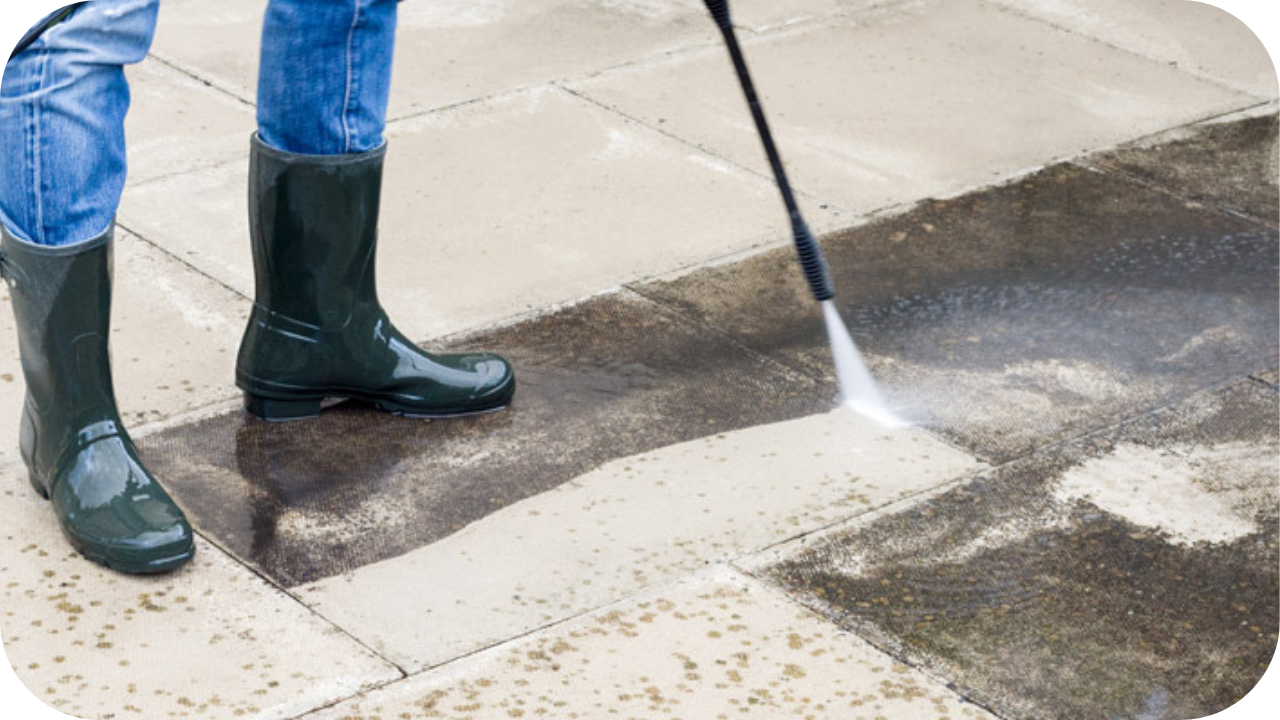
Want to upgrade your flooring but dread the messy and time-consuming tile removal process?
Tearing out existing tiles can be daunting, leading to extensive clean-up, potential damage, and high costs.
Discover how to install porcelain tiles over existing tiles with our expert tips and tricks. Learn how to achieve a stunning, durable finish without the hassle of tile removal. Read a step-by-step guide to simplifying the process and ensuring professional results.
Assessing the Existing Tile Surface
Before installing new porcelain tiles over existing ones, it’s crucial to thoroughly assess the current tile surface to ensure a successful installation.
Begin by inspecting the tiles for any signs of damage. Check for loose, cracked, or uneven tiles, as these can compromise the stability of the new layer. If you find any damaged tiles, replace them or repair the surface to create a solid foundation.
Next, ensure the existing tiles are clean and free from grease, grime, or any residue that could prevent proper adhesion.
Use a strong tile cleaner and allow the surface to dry completely. For glazed or glossy tiles, roughen the surface with sandpaper or an abrasive pad to enhance the bonding of the new adhesive.
Additionally, consider the overall flatness of the tile surface. Any protrusions or uneven areas can cause problems during the installation of the new tiles. Use a levelling compound to smooth out any irregularities, ensuring a flat and even surface for the new tiles.
Finally, the moisture levels in the area should be evaluated. Ensure there are no underlying moisture issues, which can lead to long-term problems such as mould growth or tile detachment.
Preparing the Surface
Proper surface preparation is crucial when installing porcelain tiles over existing tiles to ensure a solid and lasting bond. Here are the essential steps to prepare the surface effectively.
- Cleaning the Existing Tiles: First, thoroughly clean the existing tiles to remove all dirt, grease, and residues. Use a heavy-duty tile cleaner or a mixture of water and mild detergent. Scrub the surface with a stiff brush and rinse well to ensure no cleaning agents remain, as they can interfere with the adhesion.
- Roughening the Surface: The surface must be roughened to enhance the bond between the existing tiles and the new adhesive. Use an electric sander or angle grinder with a diamond grinding wheel to scuff the glaze of the existing tiles. This creates a textured surface, allowing the new adhesive to grip more effectively.
- Applying a Primer or Bonding Agent: After roughening the surface, apply a primer or bonding agent specifically designed for tiling over tiles. These products help improve adhesion and create a strong bond between the old tiles and the new adhesive. Follow the manufacturer’s instructions for application and drying times.
- Repairing Any Imperfections: Inspect the surface for any remaining imperfections. Fill gaps, cracks, or uneven areas with a suitable filler or levelling compound. Ensure the surface is smooth and level before proceeding with the tile installation.
Choosing the Right Adhesive
The right adhesive is essential for a successful tile-over-tile project. The glue holds everything together, ensuring your porcelain masterpiece lasts for years. Here’s what you need to consider:
- Strength and Flexibility: Porcelain tiles require a strong adhesive due to their weight and density. Opt for a high-performance adhesive specifically designed for porcelain. Look for an S1-rated adhesive, indicating its deformability and suitability for tile-over-tile applications. This flexibility helps prevent cracks and breakages caused by movement.
- Setting Time: Choose an adhesive with a setting time that suits your skill level. Faster-setting adhesives are ideal for experienced tilers while slower-setting ones provide more wiggle room for adjustments if you’re a DIY enthusiast.
- Colour: Adhesives are typically available in white or grey. Choose a colour that complements your grout for a seamless finish.
- Coverage: Calculate the area you need to cover and purchase enough adhesive for the entire project. It’s better to have a little extra than to run out halfway through.
- Brand Reputation: Stick with reputable brands known for producing quality tile adhesives. This ensures you’re getting a product that has been tested and proven to work.
Laying the New Porcelain Tiles
Properly laying the new porcelain tiles over existing tiles is crucial for achieving a professional and long-lasting finish. Here are the essential steps to follow.
- Planning the Layout: Before you start, prepare the tile layout to ensure an even and aesthetically pleasing design. Dry-lay the tiles to see how they fit and make adjustments as needed. Begin from the centre of the room or a key focal point and work your way out to avoid narrow cuts at the edges.
- Cutting Tiles to Fit: Use a wet saw or a tile cutter to make precise cuts for tiles that need to fit around obstacles, such as corners, fixtures, and edges. Measure and mark the tiles carefully to ensure accurate cuts. Always wear safety gear when cutting tiles to protect yourself from dust and debris.
- Applying Adhesive: Spread the adhesive on the prepared surface using a notched trowel. Apply the glue evenly, working in small sections to prevent it from drying before the tiles are placed. Ensure complete coverage to avoid air pockets that can weaken the bond.
- Placing the Tiles: Press each tile firmly into the adhesive, using a slight twisting motion to ensure a good bond. Use tile spacers to maintain consistent gaps between the tiles for even grout lines. Regularly check the alignment and level of the tiles as you work to ensure a smooth and professional finish.
- Final Adjustments: Once all the tiles are laid, allow the adhesive to cure for the time specified by the manufacturer. To prevent any displacement, avoid walking on the tiles during this period.
Grouting and Sealing
Grouting and sealing are the final steps in installing porcelain tiles over existing tiles, ensuring a polished and durable finish. Here’s how to do it right.
- Selecting the Appropriate Grout: Choose a high-quality grout suitable for porcelain tiles. Epoxy grout is popular due to its durability and resistance to stains and moisture. For areas prone to movement or moisture, flexible grout can help prevent cracks.
- Applying the Grout: Once the adhesive has fully cured, use a rubber float to apply the grout. Spread the grout diagonally across the tiles, pressing it into the gaps between them. Ensure all joints are filled to avoid voids that can weaken the structure. Wipe away excess grout with a damp sponge, rinsing it frequently to keep the tiles clean.
- Cleaning the Tiles: A haze may form on the tile surfaces after grouting. Once the grout has set, use a grout haze remover or a mixture of vinegar and water to clean the tiles. This ensures a spotless finish and prevents any residue from dulling the tiles.
- Sealing the Grout: To enhance the durability and longevity of your installation, apply a grout sealer. This helps protect the grout from stains, moisture, and mildew. Use a small brush or applicator to apply the sealer evenly along the grout lines. Allow it to dry according to the manufacturer’s instructions before using the tiled area.
- Final Inspection: Inspect the entire installation for any gaps or imperfections. Address any issues promptly to ensure a flawless finish.
Tips for a Successful Installation
Successfully installing porcelain tiles over existing tiles requires careful planning and attention to detail. Here are some essential tips to ensure a flawless finish.
- Work in Small Sections: Work in small sections when applying adhesive and laying tiles. This prevents the adhesive from drying out before the tiles are set, ensuring a solid bond. It also allows you to adjust and maintain alignment and level.
- Ensure Even Adhesive Application: Use a notched trowel to apply the adhesive evenly across the surface. This helps prevent air pockets and ensures complete coverage, which is crucial for the tiles to adhere correctly and stay in place.
- Maintain Consistent Grout Lines: Use tile spacers to maintain consistent gaps between the tiles. This not only ensures a neat appearance but also makes grouting easier. Consistent grout lines contribute to the tiled surface’s aesthetic and structural integrity.
- Allow Sufficient Drying Time: After laying the tiles, allow the adhesive to cure for the recommended time before grouting. This ensures the tiles are securely bonded to the surface. Similarly, let the grout set entirely before sealing and using the area.
- Regularly Check Alignment and Level: Periodically check that the tiles are aligned and level as you work. Use a spirit level to ensure the tiles are even. Making adjustments during the installation process is much easier than correcting mistakes later.
- Clean As You Go: Keep a damp sponge or cloth handy to immediately remove excess adhesive or grout. This prevents it from hardening on the tile surface, making clean-up easier and ensuring a pristine finish.
Conclusion
Installing porcelain tiles over existing tiles is a practical and efficient way to upgrade your space. Follow our expert tips for a seamless and durable finish.
Visit Splendour In Stone Melbourne for quality materials and professional advice. Contact us to start your tile transformation today.
More To Explore

Natural Stone Materials: Types, Benefits, and Choosing the Right Stone for Your Project
Natural stone is widely used in Australian homes because it offers lasting beauty, strength, and natural character in both indoor and outdoor spaces. Its variation

How to Maintain Limestone Pavers for Long Term Surface Quality
Limestone is a favourite choice for Australian outdoor spaces because its soft texture and natural warmth bring a relaxed, timeless feel to patios, pathways, and


